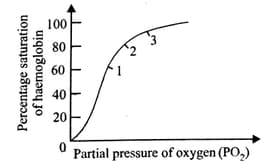HARD
NEET
IMPORTANT
Earn 100
The given graph shows an oxygen dissociation curve for haemoglobin.

Where in the body will hemoglobin be saturated at the percentages shown at points 1,2 and 3 on the graph?
(a)
1-Left ventrical
2-Pulmonary vein
3-Vena Cava
(b)
2-Left ventrical
1-Pulmonary vein
3-Vena Cava
(c)
2-Left ventrical
3-Pulmonary vein
1-Vena Cava
(d)
3-Left ventrical
2-Pulmonary vein
1-Vena Cava
50% studentsanswered this correctly

Important Questions on Breathing and Exchange of Gases
EASY
NEET
IMPORTANT
When temperature decreases, oxy-Hb curve becomes
MEDIUM
NEET
IMPORTANT
Which of the following factors is not favourable for the formation of oxyheamoglobin?
HARD
NEET
IMPORTANT
Consider the following four statements and select the correct option stating which ones are true (T) and which ones are false (F).
(i) Expiration is normally brought about by the relaxation of inspiratory muscles.
(ii) Oxyhaemoglobin can hold much less carbon dioxide in the form of carbaminohaemoglobin than what deoxyhaemoglobin can.
(iii) A person can expel all the air from the lungs by a forceful expiration.
(iv) A rise in increases the oxygen-affinity of haemoglobin.
MEDIUM
NEET
IMPORTANT
After taking a long deep breath we do not respire for some seconds due to
HARD
NEET
IMPORTANT
A large proportion of oxygen remains unused in the human blood even after its uptake by the body tissues. This
MEDIUM
NEET
IMPORTANT
In the tissues, high concentrations of carbon dioxide
EASY
NEET
IMPORTANT
Foetal haemoglobin has X affinity for oxygen than that of mother's haemoglobin during gestation. X is
HARD
NEET
IMPORTANT
Read the given statements and select the correct option.
Statement 1: About of that enters RBCs changes into HCO3 for transport in plasma to the lungs where it reconverts into for elimination.
Statement 2: About of that enters RBCs changes into carbaminohaemoglobin which releases in the lungs.
